Description
Overview
GAOTek Benchtop Ion Meter for Ammonia Ion (High Calibration Range) is designed to measure the ammonia ion concentration of samples in ppm, mg/L, mmol/L and mol/L with an accuracy of 1% F.S. This device features auto-hold function, auto and manual power off function, calibration due reminder etc. Manual temperature calibration enhances the measurement accuracy of the instrument. This benchtop meter is equipped with a huge backlit LCD display.
Key Features
- High accuracy ammonia ion meter is equipped with a large backlit LCD display.
- Calibration Due Reminder prompts you to calibrate the meter regularly.
- Selectable multiple concentration units, including the ppm, mg/L, mmol/L and mol/L.
- Auto-Hold function freezes stable reading for easy viewing and recording.
- Selectable temperature unit (°C or °F) meets different application requirements.
- mV measurement mode allows the user to check the performance of the ion selective electrode.
- Help message as an operational guide that helps the user to quickly begin using the meter.
- Automatic electrode diagnosis shows the slope of the sensor.
- Expanded memory stores and recalls up to 500 readings.
- Stored data can be transferred into a computer by USB communication interface.
- Reset feature automatically resumes all parameters back to factory default settings.
- System menu allows setting the 8 parameters, including the concentration unit, stability condition, hold function, etc.
- 2 to 5 points calibration from low to high concentrations.
- Direct ion concentration readout simplifies the elaborate measurement process.
- Stability indicator automatically shows current measurement status.
- Manual temperature calibration improves the measurement accuracy of the meter.
- Built-in real-time clock stamps stored data to meet GLP standard.
Technical Specifications
| Ion | |
| Range | 1×10-6 ~1 M, 0.02 ppm ~ 17000 ppm |
| Resolution | 0.001, 0.01, 0.1, 1 |
| Accuracy | ±1% F.S |
| Calibration Solutions | 0.001, 0.01, 0.1, 1, 10, 100, 1000, 10000 ppm, mol/L, mg/L |
| Calibration Points | 2 to 5 points |
| mV | |
| Range | -1999.9 mV ~ 1999.9 mV |
| Resolution | 0.1 mV |
| Accuracy | ±0.2 mV |
| Temperature | |
| Range | 32 °F ~ 221 °F (0 °C ~ 105 °C) |
| Resolution | 32.18 °F (0.1 °C) |
| Accuracy | ±0.9 °F, ±0.5 °C |
| Temperature Units | °F or °C |
| Calibration Range | Measured value ±50 °F (± 10 °C) |
| Others | |
| Calibration Due | 0 to 31 days |
| Temperature Compensation | 32 °F ~ 212 °F (0 °C~100 °C) |
| Compensation Mode | Manual or Automatic |
| Reset Function | Yes |
| Stability Conditions | Low or High |
| Hold Function | Manual or Automatic |
| Output | USB Communication Interface |
| Display | LCD 5.11 in×4.33 in (130 mm×110 mm) |
| Power Requirements | DC5V, using AC adapter, 220 VAC/50 Hz |
| Memory | Stores up to 500 data sets |
| Power Off | Manual or Automatic (10, 20, 30 minutes) |
| Connector | BNC |
| Dimensions | 8.26 (L) in× 7.40 (W) in× 2.36 (H) in (210 (L) mm×188 (W) mm×60 (H) mm) |
| Weight | 3.30 lbs (1.5 kg) |
Additional Information
ACCESSORIES:
- Ion Selective Electrode
- Temperature Probe
- USB Cable
- DC5V Power Adapter

Display
The device is equipped with a clear and bright LCD display that is used to show measured values, mode indicators and help message. The following table describes the meaning of each indicator.

INDEX:

Keypad
The meter has a succinct membrane keypad, names and symbols describe the each function key controls.
![]() MEAS|
MEAS|![]()
- Power the meter ON/OFF.
- Freezes the measured value on the display, press the key again to resume measuring.
- In the calibration or temperature setting mode, exits current mode and returns to measurement.
![]() MODE|oC
MODE|oC
- Toggles between available measurement modes (pH, mV, ORP).
- Press and hold the key to enter temperature setting mode.
![]() CAL|
CAL| ![]()
- Press the key to enter the calibration mode.
- Press and hold the key to enter the setup menu.
![]() MI|▲
MI|▲
- Press the key to store current measured value.
- Press▲ key in setup mode to scroll up through menu.
- Press ▲key in temperature setting mode to increase the setting values.
![]() MR|▼
MR|▼
- Press the key to view calibration report or stored data.
- Press ▼key in setup mode to scroll down through menu.
- Press ▼key in temperature setting mode to decrease the setting values.
![]() ENTER
ENTER
- Confirms the calibration, setting value or displayed option.
- Press and hold the key to turn On/Off the backlight.
Connectors
The device provides 4 connectors for connecting the various types of sensors. Listed in the below table are the details of these connectors.

INDEX:
| NO. | CONNECTOR | FUNCTION |
| 1 | ISE | For connecting the Ion Selective Electrode |
| 2 | ATC | For connecting the temperature probe |
| 3 | REF | For connecting the reference electrode |
| 4 | USB/ |
For connecting the USB cable and DC5V power adapter |
Connecting the Electrode Holder
The meter comes with an easy-to-use holder for mounting a variety of Ion Selective Electrodes and temperature probe. If necessary, please follow the steps below to install the electrode holder.
- The base of the electrode holder with an irregular round hole.

- The electrode arm has a plastic rod.

- Insert the plastic rod into the irregular round hole and swivel the electrode arm 90°. Electrode holder is now ready to swing into the desired position.

ADJUSTMENT OF ELECTRODE ARM:
After installation, if the electrode arm automatically rises or falls, you need to adjust the screws until arm locates at any position.
- Remove the plastic cover from the electrode arm.

- Use the screwdriver to tighten the screw moderately.
- Insert the plastic cover to the previous position. Installation is completed.
Connecting the Electrode
- Take out the Ion Selective Electrode from the packaging. Follow the steps below to place the electrode into left or right sides of the electrode arm.

- Insert the BNC connector into the corresponding connector socket. Rotate and push the connector clockwise until it locks. After the connection is completed, do not pull on the sensor cord. Always make sure that the connector is clean and dry.

Prior to Use
- Remove the protective cap from the bottom of the Ion Selective Electrode.
- Soak the electrode in the diluted standard solution (e.g., 100 ppm) for at least 10 minutes.

Power On/Off
- Press MEAS key to turn on the meter, the display shows measured values, mode indicators and help messages.
- Press and hold the MEAS key for 3 seconds, the meter will turn off.
- If you do not press any key within the specified time period, the meter will turn off automatically.
Setup Menu
The device contains an integrated setup menu that allows you to customize each displayed option to meet measurement requirements.

Setting the Default Parameters
- Press and hold the
 key for 3 seconds, the meter enters setup menu, the display shows selectable parameter and page number.
key for 3 seconds, the meter enters setup menu, the display shows selectable parameter and page number.

2.Press ▼or ▲ key to scroll through the menu, select the parameter you want to set (Refer to Setup Menu section).

3.Press ENTER key to confirm, the display shows an option in the submenu.

4.Press ▼or ▲ key to select the desired option.
5.Press ENTER key to confirm, the meter returns to measurement mode. The setting is completed.
EXIT THE SETUP MENU:
During the setup mode, press MEAS key, the meter returns to measurement mode immediately.
Setting the Date and Time
The device has a real time clock that is used to time-stamp stored measured value and calibration data. Follow the steps below to set the date and time during the first use.
- Press and hold the key for 3 seconds to enter the setup menu.
- Press ▼or ▲ key until the display shows “Date” option.

- Press ENTER key to confirm, the meter shows current year.

- Press ▼or ▲ key to set the year.
- Press ENTER key to confirm, the meter shows current date and time ((Format: mm-dd, hh-mm)

6.Press ▼or ▲ key to set the date and time.
7.Press ENTER key to confirm, the meter returns to measurement mode. The setting is completed.
Selecting the Calibration Points
The instrument supports ion concentration calibration up to 5 points with a minimum of 2 points, available calibration points include the following options.
| MEASUREMENT UNITS | CALIBRATION POINTS |
| ppm | 0.001, 0.01, 0.1, 1, 10, 100, 1000, 10000 |
| mg/L | 0.001, 0.01, 0.1, 1, 10, 100, 1000, 10000 |
| mol/L | 0.001, 0.01, 0.1, 1, 10 |
| mmol/L | 0.001, 0.01, 0.1 |
If you need to modify the number of calibration points, please follow the steps below.
- Press and hold
 the key for 3 seconds to enter the setup menu.
the key for 3 seconds to enter the setup menu. - Press ▲ key, the display shows “CAL/P-02” (Calibration Point) option.

- Press ENTER key to confirm, the meter enters the setting mode.
- Press ▼or ▲ key to select the number of calibration points.

- Press ENTER key to confirm, the meter returns to measurement mode. The setting is completed.
Selecting the Ion Valence
The meter is capable of connecting a variety of ion selective electrodes. For the divalent ions, you need to set the ion valence before calibration or measurement.
- Press and hold the
 key for 3 seconds to enter the setup menu.
key for 3 seconds to enter the setup menu. - Press ▲ key, the display shows “ION/P-03” (Ion Valence) option

- Press ENTER key to confirm, the meter enters the setting mode.
- Press ▼or ▲ key to select the ion valence.

- Press ENTER key to confirm, the meter returns to measurement mode. The setting is completed.
Selecting the Concentration Unit
The instrument is capable of using the mg/L, ppm or mol/L as measurement unit of concentration. The factory default is ppm. If you need to convert measurement unit, the meter must be recalibrated.
- Press and hold the
 key for 3 seconds to enter the setup menu.
key for 3 seconds to enter the setup menu. - Press ▲ key, the display shows “UNIT” option.

- Press ENTER key to confirm, the meter enters the setting mode.
- Press ▼or ▲ key to select the desired concentration unit (ppm, mg/L, mol/L).
- Press ENTER key to confirm, the “CAL” indicator will flash uninterruptedly indicating that the meter is waiting for calibrating.

- Press CAL key to enter the calibration mode or MEAS key to cancel option.
Temperature Compensation
In order to get accurate measuring results, you need to enable the manual or automatic temperature compensation before measurement or calibration.
AUTOMATIC TEMPERATURE COMPENSATION:
- Place the temperature probe into the circular hole of electrode arm.

- Insert the connector of the temperature probe into corresponding connector socket (Marked “ATC”).

- The “ATC” indicator will show on the display, the meter is now switched to automatic temperature compensation mode.
![]()
MANUAL TEMPERATURE COMPENSATION:
- Do not connect the temperature probe to meter.
- Press and hold the °C key for 3 seconds to enter temperature setting mode.
- Press ▼or ▲ key to set the temperature value of the sample.
- Press ENTER key to confirm, the meter returns to measurement mode. The setting is completed.
Ion Concentration Calibration
To obtain accurate measurement results, perform ion calibration and measurement at the same temperature. If you will not calibrate the meter or calibration is not successful, the display will always show “0.000”.
- Press MODE key until the meter shows
 indicator.
indicator.

- Press CAL key, the meter shows 0.001 ppm (or mg/L, mol/L, mmol/L).

- If necessary, press ▼or ▲ key to select the desired calibration point (e.g., 0.01 ppm).

- Rinse the Ion Selective Electrode with distilled water, then rinse with a small amount of ion standard solution.
- Dip the electrode into corresponding calibration solution. Stir the sensor gently to create a homogeneous
- Press ENTER key to confirm, “Calibration” indicator begins flashing. Wait for the measured value to stabilize, the display shows “0.1/CAL2”. The meter prompts you to continue with second point calibration.

- Rinse the Ion Selective Electrode with distilled water. Dip the electrode into corresponding calibration solution. Stir the sensor gently.
- Press ENTER key, “Calibration” indicator begins flashing. Wait for the measured value to stabilize, the display shows “1/CAL3”. The meter prompts you to continue with third point calibration.

- Repeat steps 7 to 8 above until the display shows “END”, the meter returns to measurement mode automatically. Calibration is completed.
EXIT THE CALIBRATION:
During the calibration process, press MEAS key, the meter returns to measurement mode immediately.
Ion Calibration Report
This program lets you check the slope of the Ion Selective Electrode.
- Press MR key in the ion measurement mode, the meter shows “LOC/P-01”.
- Press ▼or ▲ key until the display shows “ELE/P-02” (Electrode Diagnosis).

- Press ENTER key to confirm, the meter shows the last calibration date (Format: mm-dd).

- Press ▼ key, the meter shows calibration point and its slope.

- After the browsing, press MEAS key to exit the current mode.
Temperature Calibration
During the measurement, when automatic temperature compensation is enabled, if the temperature reading displayed differs from that of an accurate thermometer, you need to calibrate the meter.
- Press and hold the °C key for 3 seconds to enter temperature calibration mode, the display shows current temperature reading.

- Press ▼or ▲ key to set the temperature value.
- Press ENTER key to confirm. Calibration is completed.
Ion Concentration Measurement
- Press MODE key until the meter shows
 indicator.
indicator. - Rinse the Ion Selective Electrode thoroughly with distilled water. Dip the electrode into the sample solution.
- If your sample belongs to low concentration liquids or some interfering ions are present in the solution, add the Ionic Strength Adjuster into the sample solution.
- Stir the sensor gently. Wait for the reading to stabilize, record the measured value on the display.
mV Measurement
Press MODE key until the display shows measurement unit “mV”. Rinse the electrode thoroughly with distilled water. Dip the electrode into the sample solution. Wait for the measured value to stabilize, record the reading on the display.
Hold Function
The instrument contains two data hold modes. When the Auto-Hold function is enabled, the meter will automatically sense a stable endpoint reading and freeze it, “HOLD” indicator appears on the display. If the Auto-Hold function is disabled, press ![]() key, the meter will immediately freeze currently displayed value. Press the key again to resume measuring.
key, the meter will immediately freeze currently displayed value. Press the key again to resume measuring.

Storing and Recalling Data from Memory
The meter allows up to 500 data sets to be stored and recalled.
MEMORY INPUT:

During the measurement process, press MI key to input measured value into the memory, “Memory” indicator appears on the display.
MEMORY RECALL:
- Press MR key in the measurement mode, the meter shows “LOC” (Data Log).
- Press ENTER key to confirm, the meter shows page number of the stored data.

- Press ▼ key, the meter shows date and time of the stored data (Format: mm-dd).

- Press ▼ key again, the display shows the stored data.

- After the browsing, press MEAS key to exit the current mode.
Communication
The company provides a free Data Acquisition System that can be used to transfer data, receive the measuring values or import the data into Excel. Before using, ensure that Windows 7/8/10 operating system has been installed on your computer.
RECEIVING DATA:
- Connect the USB cable to meter and computer. Click the DAS icon, the system will automatically scan an available communication port and show the message box “Found a port on your computer”.
- Click the OK button, the application starts.

- Click the Connect button, the screen shows “Port is connected” indicate that communication between the meter and the computer has been established.
- Click the OK button to confirm.
- Click the Receive button, the stored data in the meter will automatically send to the computer.
INTERVAL RECORDING:
This function helps you to record the measuring value within the specified time period.
- Click the Interval Recording button and select a time option.
- Click the Receive button, the measured value will automatically send to the data sheet.
GRAPH MODE:
This function helps you to view variations of the measured parameter continuously. Click the Graph button, the screen will immediately show curve graph. If you want to quit current mode, click the Back button.
CREATE THE EXCEL FILE:
When the transfer is completed, click the “Save as Excel” button, the measured values in the data sheet will automatically convert to Excel file.
Ion Selective Electrode Care and Maintenance
Ensure that the electrode is thoroughly washed with distilled water after each use.
Do not scratch the sensitive membrane on the electrode during the measurement or calibration.
If you do not use the electrode for long periods, please store the electrode in a dry, cool and well-ventilated area.



